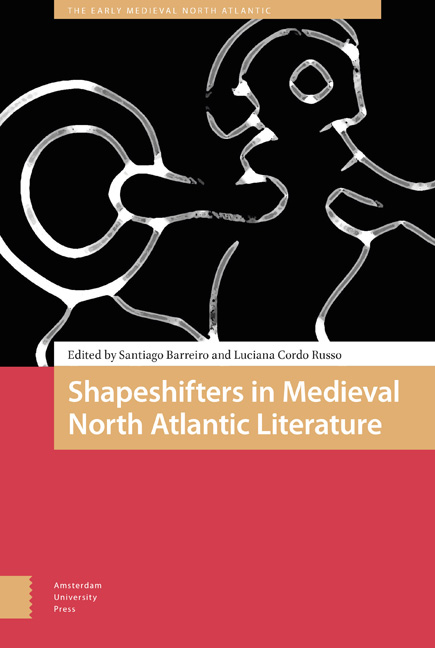Book contents
- Frontmatter
- Contents
- Acknowledgments
- Introduction: Medieval Thought and Shapeshifting
- 1 Wundor wearð on wege‘a wonder happened on the way’: Shifting shapes and meanings in Old English Riddles
- 2 The Big Black Cats of Vatnsdalr and Other Trolls: Talking about shapeshifting in medieval Iceland
- 3 The Hoard Makes the Dragon: Fáfnir as a Shapeshifter
- 4 Eigi í mannligu eðli: Shape, Monstrosity and Berserkism in the Íslendingasögur
- 5 The Cursed and the Committed: A Study in Literary Representations of ‘Involuntary’ Shapeshifting in Early Medieval Irish and Old Norse Narrative Traditions
- 6 Unde sunt aues istae?: Notes on Bird-Shapeshifting, Bird Messengers, and Early Medieval Hagiography
- 7 Sin, Punishment, and Magic: Changing Form in Medieval Welsh Literature
- Index
3 - The Hoard Makes the Dragon: Fáfnir as a Shapeshifter
Published online by Cambridge University Press: 16 February 2021
- Frontmatter
- Contents
- Acknowledgments
- Introduction: Medieval Thought and Shapeshifting
- 1 Wundor wearð on wege‘a wonder happened on the way’: Shifting shapes and meanings in Old English Riddles
- 2 The Big Black Cats of Vatnsdalr and Other Trolls: Talking about shapeshifting in medieval Iceland
- 3 The Hoard Makes the Dragon: Fáfnir as a Shapeshifter
- 4 Eigi í mannligu eðli: Shape, Monstrosity and Berserkism in the Íslendingasögur
- 5 The Cursed and the Committed: A Study in Literary Representations of ‘Involuntary’ Shapeshifting in Early Medieval Irish and Old Norse Narrative Traditions
- 6 Unde sunt aues istae?: Notes on Bird-Shapeshifting, Bird Messengers, and Early Medieval Hagiography
- 7 Sin, Punishment, and Magic: Changing Form in Medieval Welsh Literature
- Index
Summary
Abstract
This text analyses the link between treasure hoarding and shapeshifting in the stories about Fáfnir, the main antagonist of the young Sigurðr and keeper of the cursed hoard of Andvari. I examine the motif of a man who metamorphoses into a dragon in the Old Norse corpus and compare it with similar Anglo-Saxon figures, such as the Dragon in Beowulf and in the Maxims. Moreover, I argue that the native categories about dragons are different from those derived from Christian and Classical learning as known in thirteenth-century Iceland (the dragon as an allegory of evil and the dragon as a large serpent) being closely entwined with the social and literary rejection of greed and immobilised wealth.
Keywords: Dragons, Greed, Old Norse Literature, Vǫlsungar, Fáfnir.
Introduction
Fáfnir is undoubtedly the most famous dragon in Norse literature, and certainly one of the most famous in the literatures written in Germanic languages during the Middle Ages, arguably on par with the nameless beast in Beowulf. Dragons are not as abundant as popularly imagined in these literatures, although they are not as rare as Tolkien suggested, as Paul Acker has shown.Moreover, Fáfnir is arguably less stereotypically dragonesque than his Old English fire-breathing cousin, for a simple reason: he lives for a good portion of his life in bipedal, humanoid form together with his relatives, quite a different life from the seemingly lonely existence experienced by Beowulf’s last antagonist. In simple terms, Fáfnir is not a dragon, but (initially) a man.
However, his family displays a noticeable tendency towards ontological ambiguity. His relatives are described in much more detail in the Norse sources than in the English or German: we know of his brothers Reginn and Otr, his father Hreiðmarr and of two elusive sisters, Lyngheiðr and Lofnheiðr. Both the eddic poetry of the Sigurðr cycle in Snorra Edda, and Vǫlsunga saga convey a good picture of his immediate kin. For example, Reginn describes his brothers in these terms:
Otr, bróðir minn, hafði aðra iðn ok náttúru. Hann var veiðimaðr mikill ok um fram aðra menn ok var í otrs líki um daga ok var jafnan í ánni ok bar upp fiska með munni sér.
- Type
- Chapter
- Information
- Shapeshifters in Medieval North Atlantic Literature , pp. 53 - 82Publisher: Amsterdam University PressPrint publication year: 2018
- 1
- Cited by

